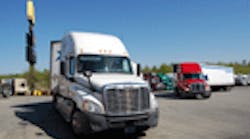The growing reservoir of real-time traffic data is increasingly being mined by many electronic navigation providers as a resource to help fleets generate more operational efficiencies; both in terms of improving on-time delivery rates as well as cutting fuel consumption.
This is especially the case where traffic data “archives” are concerned, explained Nick Cohn, senior business development manager with TomTom.
“Because we include roadway speeds with our real-time traffic updates, fleets can use that data for more efficient pre-trip planning,” he noted in an interview with Fleet Owner. “It helps them create far more efficient routes based on much more detailed data points. And we’re talking actual and not theoretical data here.”
Cohn pointed to the recent partnership TomTom forged with global traffic software developer and consulting firm PTV that will provide historical traffic data to the city of Zürich, Switzerland, to build a “historical traffic database” of more than 4 trillion anonymous data points. Combined with PTV's innovative transportation and traffic simulation software, this data allows city planners to optimize road network use and, ultimately, help reduce traffic congestion.
“We’re talking about road speed data matched to specific times during specific days of the week,” Cohn explained. “It helps indicate where longer delays may exist on local roads versus highways or vice versa. It helps demonstrate to drivers how to be more efficient, safer, and save on fuel based on the route choices they make ahead of time.”
He stressed that such usage of data is not intended to be a “wagging finger” between fleet managers and drivers; rather, it’s a way to show both parties in concrete numbers how route choices placed against historical traffic data saves money.
“It’s all part of the ‘payback story,’ quantifying exactly how much fuel can be saved mapped against expected delays on particular routes,” Cohn pointed out.
He added that the use of such data is not limited to trucking deliveries alone. For example, one project TomTom is working on involves connecting real-time traffic data from roadways with railways to improve intermodal efficiency.
“Such ‘cross-modal’ traffic data connections offer a range of improvement options,” Cohn said. “It allows for more accurate dispatch of the trucking connection, preventing unnecessary engine idling as a truck waits for a rail-born shipment to arrive at the intermodal yard; reducing fuel consumption and exhaust emissions.”



